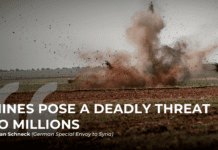Fire and Blood: The Taftanaz Massacre

Freedom’s Price is a series of articles aiming to shed light on the major massacres that have occurred during the ongoing conflict in Syria over the last 13 years. Each article highlights the crimes the Syrian people have endured in the course of their revolution and the high cost in their struggle for freedom and dignity. This installment in the series recounts the events of the Taftanaz Massacre which took place in the spring of 2012 and followed a brutal pattern of invasion, occupation, executions, arrests, torture, looting, and destruction as Assad forces rampaged through the villages of Idlib’s countryside from late March to early April. Sarmeen, Saraqib, Taftanaz, Hazano and Killy were attacked one after the other. Levant 24 spoke to survivors and witnesses of the events to understand what horrors the people experienced in their struggle for freedom.
________________________________
“Around noon the Shabiha buses arrived in our neighborhood. There was no army here, only Shabiha (pro-Assad regime gangs). There were no officers except the Alawite officers, their treatment was inhumane and despicable. I was about 13 or 14 years old at that time. An officer came and slapped me with a handful of hatred …the officer ordered the soldier to burn our house while we were inside it. The soldier entered the house – I started crying as he put our neighbor’s motorcycle inside our house to set it on fire…” Muhammad Ahmed Jaafar told L24 about the events of the last day he saw his father, the fateful day the Assad regime forces raided his village, a day that would come to be known as the Taftanaz Massacre.
The story of the Taftanaz Massacre, which unfolded in April 2012 in Syria’s Idlib province, is one of resilience, defiance, and tragedy. The attack and subsequent massacre reduced Taftanaz to rubble and ash, an estimated two-thirds of the population fled the onslaught leaving only a scant few thousand in the skeletal husk of the once vibrant village. The accounts of survivors paint a harrowing picture of relentless oppression and devastating loss.
Demonstrations and Undeterred Defiance
The roots of Taftanaz’s defiance can be traced back to the early days of the Syrian uprising in April 2011, when residents took to the streets in successive demonstrations, calling for the fall of the Assad regime and bravely challenging its iron grip on power. According to Abdullah Ghazal, an activist from the village and member of the Ghazal family which suffered the most losses, Assad’s security forces ended the first protest, yet the people continued to hold more, resulting in arrest campaigns by the regime. However, their continued calls for change were met with brutal repression, as security forces raided the town multiple times in the following months, leaving a trail of death and destruction in their wake.
“The army entered Taftanaz three times,” said Abu Muhammad, a revolutionary fighter from Taftanaz who told L24, “The first time, security entered Taftanaz and did not encounter any resistance from the revolutionary mujahideen. [This was] after the killing of a (regime) collaborator Firas Ghazal, and the revolutionaries left Taftanaz before the entry of security forces.” It was during the second raid on the village that one of Abdullah’s cousins was killed at a regime checkpoint, he was the first martyr of Taftanaz and the Ghazal family – but he wouldn’t be the last.
After that incident many were inspired to take up arms, Abu Muhammad continued, “The second time, when the army entered, the revolutionaries adopted the idea of resistance in Taftanaz due to the majority of them carrying out ambushes on the checkpoints scattered throughout the province.” Rumors had spread that the army was planning to attack, so the fighters, says Abu Muhammad, “raised barricades at the outskirts and inside the village. We cut off the main roads and planted improvised explosive devices at the entrances.”

“The members of the town belonging to the revolutionary armed groups prepared themselves fully according to their capabilities,” recalls Abdullah, “Their intention was to confront the regime forces regardless of their strength. As for civilians,” he continued, “most of them had left days before the start of the campaign, leaving only a few people intending to protect their properties and those of their relatives. This minority believed that the regime forces would not target them because they weren’t wanted by the authorities.”
Yet the wait was long and tense, “We waited for about 20 days for the army to enter, and every day passed with anticipation,” said Abu Muhammad. Until one night helicopters from Taftanaz Military Airport began constant flights over the village, “confirming all the rumors,” Abdullah recalls, “that the army would storm the town in the morning.”
Abu Muhammad recounts it was around 2 a.m. when reports of a column of tanks and armored vehicles moving towards the village from the airport reached him. He quickly took his wife and children to his parents’ home before collecting his weapon and preparing for the confrontation.
“It was a new battle for me,” he said recalling the monumental confrontation, “it was my first experience of face-to-face combat with armored vehicles, a regular army, and my own relatives and neighbors.” According to estimates by Abu Muhammad and other resistance fighters, the number of fighters from Taftanaz and neighboring villages didn’t number more than two hundred and some were “armed” simply with hunting rifles, improvised firearms and explosives or scopes and binoculars with which to track enemy movements.
The Battle Begins
On 3 April 2012, the Syrian Army launched a devastating assault on Taftanaz, shelling the town before unleashing a three-day onslaught that left it in ruins. “They began firing from the tanks and machine guns at the houses to instill terror. The campaign was led by Colonel Noufal Al-Hussein, the military security chief in Idlib,” Abdullah commented. Once the onslaught began many who had stayed behind realized Assad’s forces had no intention of showing any quarter.
Human Rights Watch (HRW) collected the testimonies of many survivors painting a stark picture of the atrocities endured by civilians, in the attack and exposing the brutal tactics employed by the Assad regime forces.
Many were killed in the first moments while trying to escape. Ali Maassos, aged 76, and his 66-year-old wife, Badrah, were mercilessly gunned down as they attempted to flee the chaos in a pickup truck with over 15 friends and family members. One of their relatives, Ibrahim, recounted the horrific ordeal, “There were no armed men in or anywhere near the car… I was certain that it was the soldiers in a tank who were shooting at them.” Badrah was killed instantly, while Ali, shot in his shoulder and throat, died five days later.

The indiscriminate violence spared no one. “Miriam’s” family, asleep in their home, awoke to the sound of shelling. Desperate to escape, they piled into a truck, fleeing for safety. But salvation eluded them as bullets tore through the air. Miriam described the terror of being caught in the crossfire as she attempted to escape with her family. “As we were getting into the truck, the helicopters were shooting… The bullet hit me in the left thigh; I was terrified because I had my baby son on my lap.” Many civilians were killed in their homes or while trying to escape before realizing they were trapped, they took refuge in basements and barricaded themselves in their homes.
Retreat and Revenge
After the initial assault, the tanks and armored troop carriers were able to enter the village. The fighters were outnumbered and unable to counter the combined air and ground forces of the helicopters and the infamous 79th Armored Battalion also known as the “Brigade of Death.” The tanks quickly rolled through the defenses and the fighters were hard-pressed to defend the town as the eastern and southern sides became overrun.
Abu Muhammad recalled the moments the decision to retreat was made, “I met with the remaining revolutionaries and learned that my brother had been arrested and several other mujahideen had been martyred. However, we knew little about the real extent of the massacre. We debated whether to fight or leave the town and due to the shortage of ammunition and lack of anti-tank weapons, we chose to leave.” It was only after the retreat of the fighters and armed resistance stopped that the real killing began.
All accounts agree that the Ghazal family bore the brunt of the violence, with multiple members targeted for their affiliation with the Free Syrian Army (FSA) and as retribution for the murder of a regime collaborator who was killed by one of his cousins aligned with the revolution. Abdullah Ghazal recounts, “Among the regime forces were security elements from the town, including one of the Ghazal family, whose brother worked with military intelligence and had been killed earlier by his cousins. So, he directed the regime elements to seek revenge, leading to extensive burning, looting, and killing within this family.”
Fadi Ghazal, a survivor haunted by the memories, recounted the horrors that he discovered following the massacre. “First we found five bodies in a little shop next to the house,” he recalled. “They were almost completely burned… Then we entered the house and in one of the rooms found nine bodies on the floor, next to the wall. There was a lot of blood on the floor.” His words echoed the devastation witnessed by many in Taftanaz that fateful day. But Fadi’s account was just one of many, each bearing witness to the vengeful atrocities committed by the regime’s forces against the Ghazal family and others.

Even the elderly were shown no mercy. 75-year-old Ghassan Ghazal was executed in his own home, his son recounting the horrifying events that unfolded before his eyes. “There were seven or eight soldiers in uniforms… They demanded that Ghassan open his safe. His family (in another room) heard a gunshot,” he told HRW, when the soldiers left, his family emerged to find the safe open and Ghassan dead on the floor with a gunshot wound on the back of his head.
Assad’s forces went house to house, looting, detaining, and executing innocent civilians, including 52-year-old Ibrahim Ghazal and his 42-year-old brother Omar. Ibrahim’s son tearfully recounted the tragic fate that befell his father and uncle, stating, “Later in the evening, neighbors called the family, who were hiding in the house… Ibrahim and Omar’s bodies were lying about 50 meters from the entrance to their house.”
Salma, a mother of eight, endured a harrowing ordeal at the hands of soldiers demanding her husband’s whereabouts. Her husband and oldest son had left Taftanaz before the soldiers arrived, knowing they would likely be killed, when Salma said, “he is at work and cannot be reached” they threatened to burn her and her children alive. “They put a Kalashnikov to my head and threatened to kill us all… My young daughters were crying and begging them to let us go,” she recounted. They were eventually allowed to leave the house before it was burned down.
Jaafar and his mother were also spared a similar fate, after seeing his father abused and beaten by Shabih and Alawite officers, Jaafar was beaten before being sent home while his father was loaded into a military troop carrier, never to be seen again. He heard an officer order one of the soldiers to burn the pair alive in their house. “He must have felt pity for us,” Jaafar posits, “[the officer] said, ‘I will go out of the house and tell the officer that I burned the house, I’ll put the motorcycle in front of the door and light it on fire, but you must not leave the house at all. This is safe for you and for me so that I am not questioned by the officer or executed.”
Assad or we Burn the Country…
Days later the fighters returned to the village, “Upon our return,” said Abu Muhammad, “we were shocked to find that half of the houses in Taftanaz had been burnt and completely destroyed. The bodies of dozens of people, some of whom I recognized, lay scattered around. It was an unimaginable scene of hatred and destruction. The bodies, including those of children, women, and elders, were mutilated after being killed. Mosques were burnt, and sectarian slogans were written on the walls.”
Muhammad Ayman Ezz told HRW his experience of being detained by soldiers. While in their custody, he witnessed soldiers firing at and damaging Al-Kabir Mosque. They set ablaze several homes, including the residence of the local sheikh and a prominent community activist. HRW investigators documented the extensive damage inflicted upon Al-Kabir Mosque. The minaret and portions of the walls bore signs of damage, likely from tank fire. Inside, the scene was one of utter destruction, with shattered glass, torn carpets, and broken furniture strewn across the floor. Every surface bore the scars of bullet marks, leaving the walls and ceiling riddled with impact craters.

The near entire destruction in the Sunni village, coupled with the presence of the Alawite death squads, the Shabih, and attacks on religious buildings and graffiti with sectarian slogans in the homes, places of worship, and ruins left no doubt of the sectarian component to the massacre.
Hope Among the Ashes
The scale of the massacre was staggering, with at least 62 civilians murdered, including 39 members of the Ghazal family. As the smoke cleared and the dust settled, it became apparent that the toll was not just measured in lives lost but in the shattered hopes and dreams of a community torn apart by violence. At least 490 houses were partially or completely burnt down and 150 homes were partially or completely destroyed by tank fire or demolition charges.
“There were lots of villages around that had just started protesting and [the regime] wanted to say, ‘This is what we can do to you,’” Sahir Schaib, a local fighter told the AP reporter Ben Hubbard months after the massacre, “They committed the massacre to teach the whole region a lesson.”

Many families left, some to Turkey others to nearby villages or other areas, yet the spirit of the people of Taftanaz was not crushed by the massacre. Abu Muhammad reflects on the aftermath and its impact on the people and revolution, “with time, we learned to absorb the shock and draw strength from it. This battle taught us many lessons, it united the people of Taftanaz as one family and showcased the generosity of neighboring villages, who provided aid in abundance. It was the first time in my life that I witnessed such solidarity – which was previously absent. It was a tragic day, but it awakened dormant spirits within us. Our strength persevered, and our revolution continued to bear fruit, ensuring a brighter future for generations to come, by the will of Allah.”









